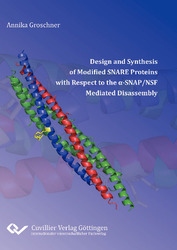| Areas | |
|---|---|
| Serie de libros (96) |
1378
|
| Nachhaltigkeit |
3
|
| Gesundheitswesen |
1
|
| Letra |
2363
|
| Ciencias Naturales |
5406
|
| Matemática | 229 |
| Informática | 319 |
| Física | 980 |
| Química | 1363 |
| Geociencias | 131 |
| Medicina humana | 243 |
| Estomatología | 10 |
| Veterinaria | 108 |
| Farmacia | 147 |
| Biología | 835 |
| Bioquímica, biología molecular, tecnología genética | 121 |
| Biofísica | 25 |
| Nutrición | 45 |
| Agricultura | 1004 |
| Silvicultura | 201 |
| Horticultura | 20 |
| Ecología y conservación de la tierra | 148 |
| Ciencias Ingeniería |
1791
|
| General |
98
|
|
Leitlinien Unfallchirurgie
5. Auflage bestellen |
|
Erweiterte Suche
Design and Synthesis of Modified SNARE Proteins with Respect to the α‐SNAP/NSF Mediated Disassembly (Tienda española)
Annika Groschner (Autor)Previo
Indice, Datei (110 KB)
Lectura de prueba, Datei (250 KB)
Soluble N-ethylmaleimide-sensitive attachment receptor (SNARE) proteins are the
key players in membrane fusion. Localized in opposed membranes, they assemble via
the SNARE motif in a stable four-helix bundle bringing the membranes close to each
other and promoting membrane fusion by using the energy release during complex
formation. SNARE complex assembly is regulated by several proteins. One of these,
Complexin, is known to partially associate with the core complex, it may stabilize
SNARE complex intermediates and unbinds upon calcium trigger. Nevertheless, the
exact function of Complexin is still under discussion. After membrane fusion the
recycling of free SNARE proteins is mediated by the AAA+ protein NSF in conjunction
with its cofactor a-SNAP. Afterwards, the individual SNARE proteins are available for
another round of membrane fusion.
To date, no effective model systems for preventing or at least decelerating the
disassembly mechanism are known. Development of a potent inhibitor of the a-
SNAP/NSF mediated disassembly was carried out. Therefore, the SNARE motif of
Synaptobrevin, one of the SNARE proteins, was used as a model system for the
investigation of defined SNARE/SNAP complex recognition sites. The full length of the
SNARE motif of Synaptobrevin was obtained using solid phase peptide synthesis.
Different modifications at various residues within the sequence were introduced in
order to identify important interactions between a-SNAP and the SNARE complex and
to prevent a-SNAP recognition.
Additionally, the regulator protein Complexin was synthesized as a ß-peptide analog,
also designed to inhibit the disassembly mechanism by preventing a-SNAP
recognition through enhanced interaction between the ß-mimic and the
Synaptobrevin and Syntaxin helices. By development of the Complexin ß-peptide
mimic as a 14-helix, the advantages of a well-defined secondary structure with high
helix propensity are obtained. Furthermore, the binding fragment of Complexin was
performed as a-peptide, extended with amino acids known to promote the a-helical
propensity.
For understanding of biological systems the investigation of conformational dynamics
and interactions of individual proteins is important. Therefore, in a final part, small
independently folding protein domains were synthesized by solid phase peptide
synthesis and labeled with respect to the development of the single molecule
fluorescence spectroscopy (smFRET) technique. This method is a convenient tool of
monitoring single folding and unfolding events of proteins.
| ISBN-10 (Impresion) | 3869556625 |
| ISBN-13 (Impresion) | 9783869556628 |
| ISBN-13 (E-Book) | 9783736936621 |
| Formato | A5 |
| Idioma | Inglés |
| Numero de paginas | 188 |
| Laminacion de la cubierta | mate |
| Edicion | 1 Aufl. |
| Volumen | 0 |
| Lugar de publicacion | Göttingen |
| Lugar de la disertacion | Universität Göttingen |
| Fecha de publicacion | 22.02.2011 |
| Clasificacion simple | Tesis doctoral |
| Area |
Química
|








